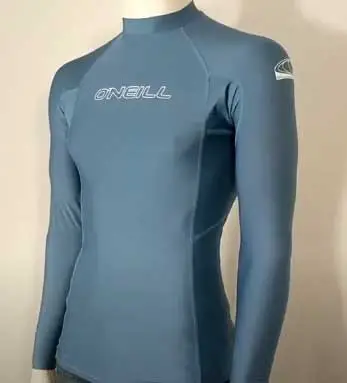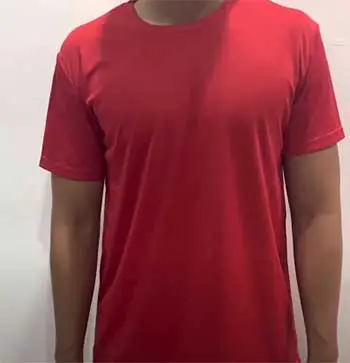Rash guards and dri fit shirts are two popular types of athletic shirts designed for sports and outdoor activities. But what exactly are they, and how do they differ?
This comprehensive guide will compare rash guards and dri fit shirts on factors like material, breathability, UV protection, drying time, odor control, and more.
A Direct Comparison Table
| Factor | Rash Guard | Dri Fit Shirt |
| Main Uses | Water sports, grappling, friction/impact activities | Running, training, aerobic activities |
| Fabric | Nylon, polyester/spandex blends | Polyester microfiber, polyester/elastane |
| Fit | Tight compression | Slim, athletic |
| Feel | Stretchy, “second skin” | Lightweight, non-compressive |
| UPF Sun Protection | Often included | Not inherent, some models rated UPF |
| Ventilation | Limited, focused on protection | Mesh zones, highly breathable |
| Graphics | Bold prints, colors, patterns | Minimal, subtle |
| Durability | Highly durable | Susceptible to wear over time |
What Is A Rash Guard?
A rash guard is a lightweight, stretchy, quick-drying shirt designed to be worn in water sports and athletics. Rash guards are often worn for:

- Surfing
- Swimming
- Snorkeling
- Scuba diving
- Watersports like water polo
- Grappling sports like MMA, BJJ, wrestling
- Other outdoor sports like paddleboarding
The main benefits of a rash guard are protection and performance.
The tight fit creates a second skin to prevent chafing and rashes during activities with abrasion and friction.
The material is also highly elastic to allow unrestricted mobility.
Rash guards are made of polyester or nylon/spandex blends. Thicker options have UPF protection from the sun’s rays. They come in short sleeve, long sleeve, and full suit styles covering the torso and thighs. Sleeveless rash guard vests are also popular.
Surfers started wearing rash guards to prevent wetsuit chafing. Now rash guards are ubiquitous in watersports and combat sports for their combination of protection, flexibility, and quick-drying performance.
What Is A Dri Fit Shirt?
Dri fit shirts are athletic tops made by brands like Nike, Adidas, and Under Armour. The fabric is designed to wick moisture and sweat away from the body to keep you cool and dry during physical activity.
Dri is short for “dri-FIT”, Nike’s proprietary polyester microfiber fabric optimized for moisture management. Other brands market similar fast-drying performance fabrics under names like ClimaCool (Adidas) and HeatGear (Under Armour).
Dri fit shirts are popular for:

- Running
- Workouts and training
- Tennis
- Soccer, basketball, and other field sports
- Outdoor activities like hiking and rock climbing
The ultra-breathable material evaporates sweat quickly to regulate body temperature.
The fabrics also resist clinging from perspiration.
This prevents discomfort and chilling as moisture evaporates.
Dri fit shirts come in short sleeve and sleeveless styles in a slim, athletic fit.
They are made of lightweight polyester or poly-blend fabrics that are highly stretchy and flexible. Many feature mesh ventilation zones for enhanced breathability during intense exercise.
Rash Guard And Dri Fit: Key Differences
Now that you know the basics, let’s compare some key differences between rash guards and dri fit athletic shirts:
Main Uses
- Rash guards are designed for water sports and grappling where skin protection is needed. They are commonly worn for surfing, diving, MMA, wrestling, and similar friction-intensive sports.
- Dri fit shirts are optimized for land-based sports and training where wicking sweat away is the priority. They excel at running, workouts, field sports, and other highly aerobic activities.
Fabric and Composition
- Rash guards typically use nylon or polyester/spandex fabric blends. The material is thick and stretchy to provide a protective second skin.
- Dri fit shirts favor lightweight polyester microfibers or polyester/elastane blends. The thin, breathable material maximizes airflow and sweat wicking.
Fit and Feel
- Rash guards have a tight compression fit to prevent chafing without restricting movement. The stretchy material creates a “second skin.”
- Dri fit shirts have a slim, athletic fit while remaining lightweight and non-compressive. The fabrics have superior mechanical stretch and recovery.
UV Protection
- Rash guards often provide UPF (ultraviolet protection factor) sun protection through denser weaves and/or UV-blocking fabrics.
- Dri fit shirts do not inherently provide UPF protection on their own. Some shirts may be rated UPF if engineered specifically for sun protection.
Ventilation Zones
- Rash guards focus on protection so have minimal venting. Some have mesh gussets in the armpit or back for limited increased breathability.
- Dri fit shirts maximize ventilation with mesh zones along the back and under arms. Seamless constructions also enhance air circulation.
Prints and Graphics
- Rash guards commonly feature colorful prints, patterns, and graphics inspired by surf and beach culture. They allow personal style expression.
- Dri fit shirts have minimal designs and limited color options. Darker shades are preferred to show less visible sweat. Bold prints are less common.
Pros and Cons of Rash Guards
Pros
- Prevent chafing, rashes, and skin abrasion during friction sports
- Flexible, unrestrictive range of motion
- UPF protection options for sun safety
- Compression fit reduces muscle fatigue
- Cool prints and graphics for self-expression
- Durable construction stands up to wear and tear
Cons
- Less breathable than dri fit shirts
- Limited ventilation can cause overheating
- Tight fit may feel restrictive to some
- Compression causes difficulty putting on/taking off
- Darker colors show sweat more visibly
Pros and Cons of Dri Fit Shirts
Pros

- Ultra-breathable sweat-wicking performance
- Mesh ventilation zones keep you cooler
- Lightweight, non-compressive fit for comfort
- Stretch fabrics allow free, unrestricted motion
- Easy to put on and take off
- Quick drying time after activity
Cons
- No inherent UPF sun protection
- Minimize prints/colors which can show sweat
- Fabric stink can develop over time
- Requires washing after every wear to prevent odor
- Pilling can develop from friction during activity
- Not durable enough for abrasion/friction sports
Also Read: How Polo Blake And Classic Fit Shirts Stack Up?
Frequently Asked Questions (FAQ)
The main differences are that rash guards provide protection from abrasion and sun exposure while dri fit shirts focus on moisture wicking performance. Rash guards use thicker nylon/spandex while dri fit favors ultra-breathable polyester. Rash guards have a tight compression fit and bold graphics compared to the lightweight athletic fit and subtle styles of dri fit.
Yes, rash guards are designed to dry very quickly despite being thicker than dri fit fabrics. The nylon and polyester blends are hydrophobic to repel water. Tighter weaves prevent absorption while the stretchiness and compression cause the fabric to spring back rapidly. Most good quality rash guards will dry within 30-60 minutes after getting wet.
For water sports, a slim-fit UV protective shirt or swim top can substitute for a rash guard. For grappling sports, form-fitting base layer tops work. Compression shirts and sticky mat surf shirts mimic aspects of rash guards as well.
For casual wear, substitutes like swim tops, crop tops, or any athletic shirt with good stretch will give a similar look and feel to a rash guard without the compression.
Rash guards and compression shirts both use stretchy spandex-blend fabrics. But rash guards prioritize protection through a tighter, “second skin” fit. Compression shirts focus mainly on muscle support and recovery. Rash guard fabrics are also more durable to withstand friction, while compression shirts are optimized for breathability and moisture wicking.
The Bottom Line
When to Choose Rash Guards
Rash guards excel at water sports and activities involving abrasion, grip fighting, and impact where their protective second skin is beneficial. Their UPF properties also make them ideal for extended sun exposure.
Rash guards’ vibrant prints and colors allow you to express personal style.
When to Choose Dri Fit Shirts
Dri fit shirts dominate for high intensity training and aerobic sports on land where breathability and sweat wicking are essential. Their lightweight, ventilated construction keeps you cooler as your heart rate rises.
Dri fit shirts also offer a minimalist athletic look preferred by runners and gym goers.
Try Them Both to See What You Prefer!
Rash guards and dri fit shirts both make excellent athletic tops with strengths in different sports and scenarios. Your personal preferences around fit, feel, and features will determine which becomes your go-to workout shirt.
Try wearing each for your main activities to gauge what excels for your needs. Mix and match Dri fit for your training and rash guards for water activities to get the best of both worlds!



